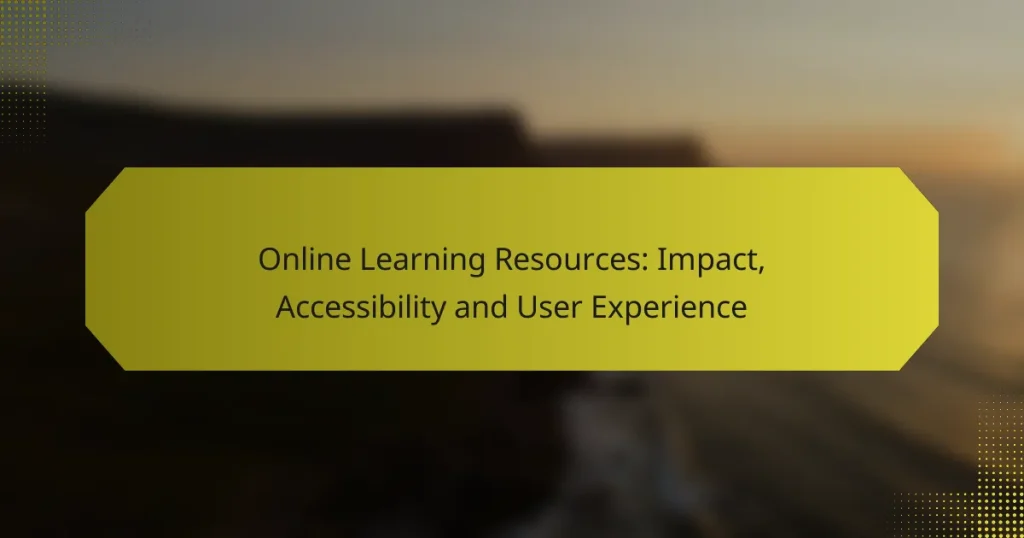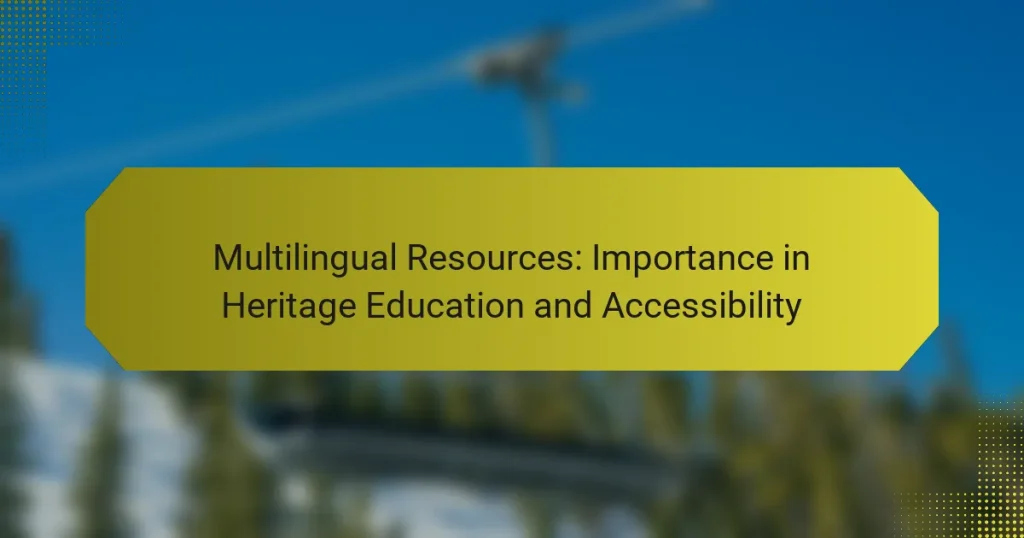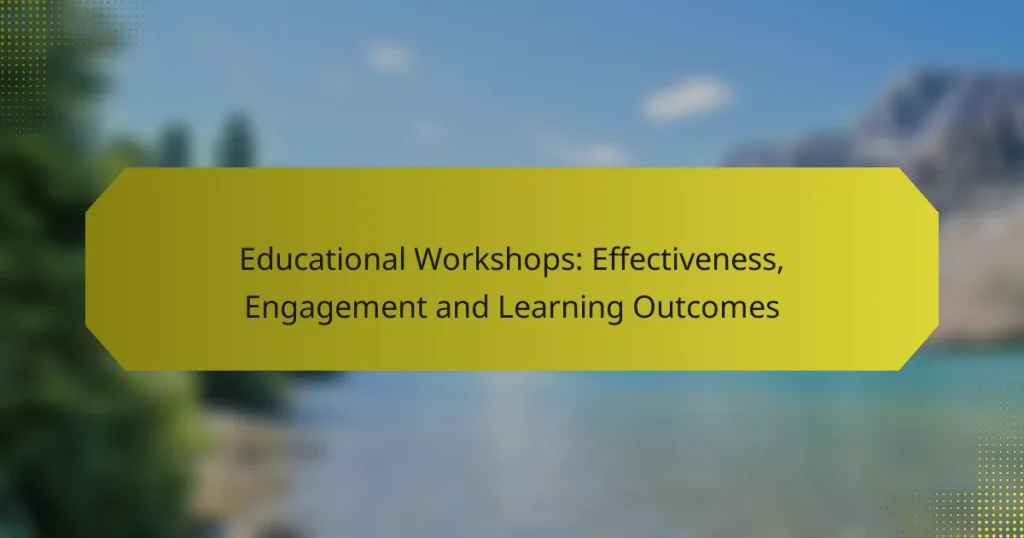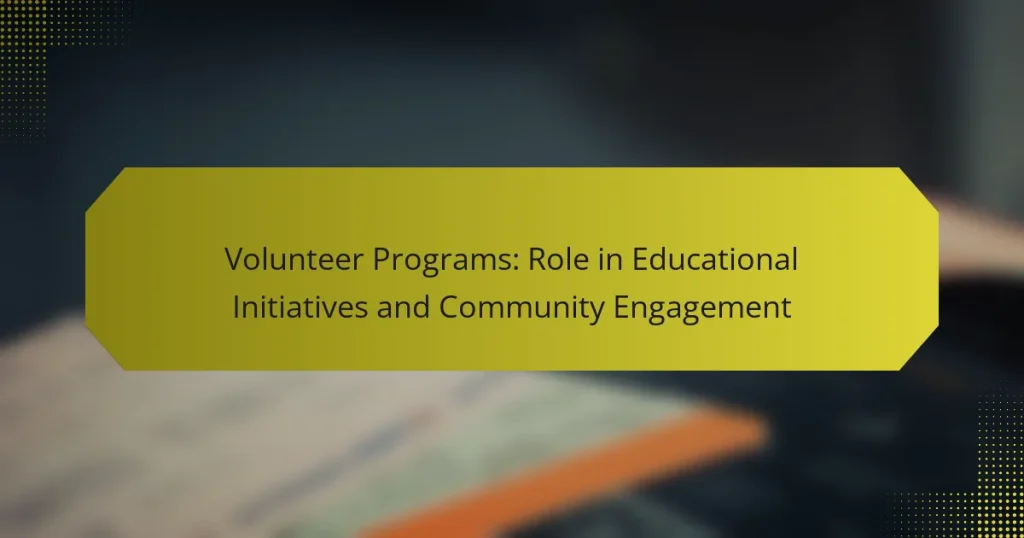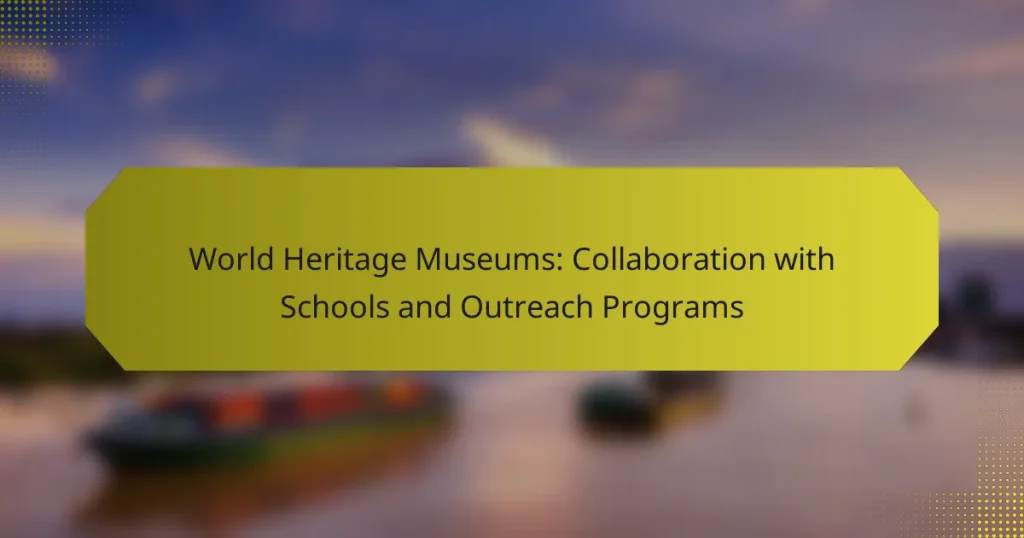World Heritage Museums offer a range of educational programs designed to deepen visitor engagement and appreciation for cultural heritage. Through guided tours, interactive exhibits, and online learning opportunities, these programs cater to various age groups and interests, making the exploration of history both enjoyable and insightful.
Online Learning Resources: Impact, Accessibility and User Experience
Curriculum-Based Programs: Comparison and Educational Value
Multilingual Resources: Importance in Heritage Education and Accessibility
Educational Workshops: Effectiveness, Engagement and Learning Outcomes
Volunteer Programs: Role in Educational Initiatives and Community Engagement
World Heritage Museums: Collaboration with Schools and Outreach Programs
What educational programs are offered in World Heritage Museums in Europe?
World Heritage Museums in Europe provide a variety of educational programs aimed at enhancing visitor engagement and understanding of cultural heritage. These programs often include guided tours, interactive exhibits, and online learning opportunities tailored to different age groups and interests.
Guided tours and workshops
Guided tours in World Heritage Museums typically offer in-depth insights into the exhibits and the historical significance of the artifacts. These tours can last anywhere from one to three hours, depending on the museum and the specific focus of the tour.
Workshops often accompany these tours, allowing participants to engage hands-on with art or history. For example, a workshop might involve traditional crafts or techniques related to the museum’s collection, fostering a deeper appreciation of cultural practices.
Interactive exhibits for children
Many World Heritage Museums feature interactive exhibits designed specifically for children, making learning fun and engaging. These exhibits often include touch screens, games, and activities that encourage exploration and creativity.
For instance, a museum might have a scavenger hunt that guides children through the exhibits, prompting them to discover key facts about the artifacts. Such interactive experiences can significantly enhance children’s understanding and retention of historical information.
Online courses and webinars
Online courses and webinars have become increasingly popular, especially in the wake of recent global events. Many museums now offer virtual learning opportunities that cover various topics related to their collections and heritage.
These courses can range from short, introductory sessions to more comprehensive programs lasting several weeks. Participants can often engage with experts and ask questions, making these online formats a valuable resource for those unable to visit the museums in person.
How do educational programs enhance visitor experience in World Heritage Museums?
Educational programs significantly enhance visitor experience in World Heritage Museums by providing deeper insights into cultural heritage and fostering engagement. These programs often include interactive elements that make learning enjoyable and memorable, allowing visitors to connect with the exhibits on a personal level.
Engagement through storytelling
Storytelling is a powerful tool used in educational programs to captivate visitors. By weaving narratives around artifacts and historical events, museums can create emotional connections that resonate with audiences. For instance, a program might explore the life of a historical figure associated with a particular exhibit, bringing the past to life.
Effective storytelling often incorporates multimedia elements such as videos, audio guides, or live performances, enhancing the immersive experience. This approach not only informs but also entertains, making the museum visit more impactful and enjoyable.
Hands-on learning opportunities
Hands-on learning opportunities allow visitors to engage directly with the material, fostering a deeper understanding of the content. Programs may include workshops, interactive displays, or guided activities where participants can touch, create, or experiment with historical techniques or artifacts.
For example, a museum might offer a pottery workshop where visitors can try their hand at ancient crafting methods. Such experiences encourage active participation and can be particularly effective for families and school groups, making learning both fun and educational.
What are the benefits of participating in educational programs at World Heritage Museums?
Participating in educational programs at World Heritage Museums offers numerous advantages, including enhanced cultural understanding and the development of valuable skills. These programs provide immersive experiences that connect individuals with diverse histories and artistic expressions.
Increased cultural awareness
Educational programs at World Heritage Museums foster increased cultural awareness by exposing participants to various traditions, histories, and artistic practices from around the world. Engaging with authentic artifacts and expert-led discussions helps individuals appreciate the significance of cultural heritage.
For instance, workshops that focus on local crafts or storytelling traditions can deepen understanding of a community’s values and beliefs. This awareness not only enriches personal knowledge but also promotes respect and empathy towards different cultures.
Skill development in art and history
These programs also facilitate skill development in art and history, equipping participants with practical abilities and critical thinking skills. Through hands-on activities, such as art creation or historical analysis, individuals can enhance their creativity and analytical capabilities.
For example, a program might include art workshops where participants learn techniques from various cultures, or history seminars that encourage critical discussions about historical events. Such experiences can be particularly beneficial for students and professionals looking to expand their expertise in these fields.
What criteria should be considered when selecting educational programs in World Heritage Museums?
When selecting educational programs in World Heritage Museums, consider factors such as age appropriateness, program content relevance, and accessibility options. These criteria ensure that the programs effectively engage diverse audiences and meet their educational needs.
Age appropriateness
Age appropriateness is crucial for ensuring that the content resonates with participants. Programs should be tailored to different age groups, from young children to adults, with activities designed to match their cognitive and emotional development.
For example, interactive storytelling may be suitable for children aged 5-10, while more complex discussions about heritage conservation might be better suited for teenagers and adults. Always check the museum’s recommendations for age-specific programs to enhance engagement.
Program content relevance
Program content relevance ensures that the educational material aligns with the interests and needs of the audience. It is important to select programs that connect with current educational standards or cultural themes relevant to the community.
For instance, a program focusing on local history can enhance students’ understanding of their heritage, while international themes may broaden their perspectives. Review the program descriptions carefully to ensure they meet your educational goals.
Accessibility options
Accessibility options are essential for making educational programs inclusive for all participants. Consider whether programs provide accommodations for individuals with disabilities, such as wheelchair access, sign language interpretation, or materials in multiple languages.
Check if the museum offers sensory-friendly sessions for individuals with autism or other sensory sensitivities. Ensuring that programs are accessible can significantly enhance participation and learning experiences for everyone involved.
What are the costs associated with educational programs in World Heritage Museums?
The costs associated with educational programs in World Heritage Museums can vary significantly based on the type of program, duration, and location. Generally, these costs may include admission fees, materials, and potential membership discounts that can help offset expenses.
Admission fees for programs
Admission fees for educational programs in World Heritage Museums typically range from low tens of USD to several hundred USD, depending on the program’s complexity and duration. For example, workshops or guided tours may cost between 20 to 100 USD per participant, while more extensive courses or special events can exceed 200 USD.
It’s essential to check the museum’s website or contact them directly for specific pricing details, as some museums may offer free admission for certain educational events or during specific times of the year.
Membership discounts
Many World Heritage Museums offer membership programs that provide discounts on educational programs. Membership fees can vary, often ranging from 50 to 150 USD annually, and members may receive up to 50% off admission fees for educational events.
Additionally, some museums offer family or student memberships that can further reduce costs. Consider becoming a member if you plan to participate in multiple programs, as this can lead to significant savings over time.
How can technology enhance educational programs in World Heritage Museums?
Technology can significantly enhance educational programs in World Heritage Museums by providing immersive and interactive experiences that engage visitors more deeply. Tools like virtual reality and mobile applications facilitate learning by making historical and cultural content accessible and engaging.
Virtual reality experiences
Virtual reality (VR) experiences allow visitors to immerse themselves in historical settings, offering a unique perspective on the artifacts and stories presented in World Heritage Museums. Through VR headsets, users can explore ancient civilizations or significant events as if they were part of them, enhancing their understanding and retention of information.
When implementing VR, museums should consider the technical requirements, such as hardware compatibility and user comfort. Additionally, creating content that is both educational and entertaining is crucial to maintain visitor interest and engagement.
Mobile apps for interactive learning
Mobile apps can transform the museum experience by providing interactive learning tools that visitors can use during their visit. These apps often include features like guided tours, quizzes, and augmented reality elements that bring exhibits to life, making learning more dynamic and personalized.
To maximize the effectiveness of mobile apps, museums should ensure they are user-friendly and accessible across various devices. Incorporating feedback mechanisms can help improve the app’s content and functionality over time, catering to the evolving needs of visitors.
What emerging trends are shaping educational programs in World Heritage Museums?
Emerging trends in educational programs at World Heritage Museums focus on integrating technology, promoting inclusivity, and emphasizing sustainability. These trends aim to enhance visitor engagement and foster a deeper understanding of cultural heritage.
Focus on sustainability education
Sustainability education in World Heritage Museums emphasizes the importance of preserving cultural and natural heritage for future generations. Programs often include workshops, guided tours, and interactive exhibits that highlight sustainable practices and environmental stewardship.
For instance, museums may host community events that teach visitors about local ecosystems and conservation efforts. By incorporating hands-on activities, such as planting native species or participating in clean-up initiatives, museums can engage audiences in meaningful ways.
To implement effective sustainability education, museums should consider partnerships with local environmental organizations. This collaboration can provide resources, expertise, and credibility, enhancing the educational impact of their programs. Additionally, museums should regularly evaluate their initiatives to ensure they align with current sustainability standards and practices.

